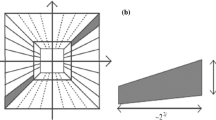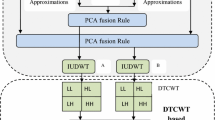Abstract
Though bi-orthogonal filtering (BWF) algorithm has been applied in image processing, the image after processing still has the phenomenon of edge distortion. To improve the image processing effect of BWF algorithm, genetic algorithm was introduced to optimize BWF algorithm, and optimized biorthogonal filtering algorithm (OBWF) was established. Computed tomography (CT), magnetic resonance imaging (MRI), and digital subtraction angiography (DSA) were employed as biomedical imaging data processing objects. The results of OBWF algorithm and other algorithms were analyzed under the same conditions regarding the changes of the peak signal to noise ratio, structural similarity index (SSIM), normalized mean absolute deviation (NMAD), background contrast (C), and mean offset CII index. The results showed that the PSNR and SSIM of the biomedical image data processed by the OBWF algorithm were higher and the NMAD value was lower than those of other algorithms. The C of the biomedical image after processing by the OBWF algorithm was 0.2393 higher than that of the BWF, and the CII was 0.9862 higher than the discrete sequence wavelet transform (DSWT) algorithm. The processing times of OBWF algorithm for CT, MRI, and DSA biomedical image data were 3.029 s, 2.239 s, and 68.745 s, respectively, which were lower than the times of other algorithms (P < 0.001). In short, OBWF could improve the quality of biomedical image data and reduce the running time, which provided a reference for data processing of biomedical images.













Similar content being viewed by others
References
Uchitel J, Vidal-Rosas EE, Cooper RJ, Zhao H (2021) Wearable, integrated EEG-fNIRS technologies: a review. Sensors (Basel) 21(18):6106. https://doi.org/10.3390/s21186106
Schneeweiss S, Brown JS, Bate A, Trifirò G, Bartels DB (2020) Choosing among common data models for real-world data analyses fit for making decisions about the effectiveness of medical products. Clin Pharmacol Ther 107(4):827–833. https://doi.org/10.1002/cpt.1577
Anagnostakou V, Ughi GJ, Puri AS, Gounis MJ (2021) Optical coherence tomography for neurovascular disorders. Neuroscience 474:134–144. https://doi.org/10.1016/j.neuroscience.2021.06.008
Womac ND, Neptune RR, Klute GK (2019) Stiffness and energy storage characteristics of energy storage and return prosthetic feet. Prosthet Orthot Int 43(3):266–275. https://doi.org/10.1177/0309364618823127
Luijten B, Cohen R, de Bruijn FJ et al (2020) Adaptive ultrasound beamforming using deep learning. IEEE Trans Med Imaging 39(12):3967–3978. https://doi.org/10.1109/TMI.2020.3008537
Zhang S, Zhi L, Zhou T (2020) Medical image retrieval using empirical mode decomposition with deep convolutional neural network. Biomed Res Int. https://doi.org/10.1155/2020/6687733
Kumar SN, Lenin Fred A, Sebastin VP (2018) Compression of CT Images using contextual vector quantization with simulated annealing for telemedicine application. J Med Syst 42(11):218. https://doi.org/10.1007/s10916-018-1090-7
Zordan-Bronzel CL, Esteves Torres FF, Tanomaru-Filho M, Chávez-Andrade GM, Bosso-Martelo R, Guerreiro-Tanomaru JM (2019) Evaluation of physicochemical properties of a new calcium silicate-based sealer Bio-C Sealer. J Endod 45(10):1248–1252. https://doi.org/10.1016/j.joen.2019.07.006
Vp B, Chinara S (2021) Automatic classification methods for detecting drowsiness using wavelet packet transform extracted time-domain features from single-channel EEG signal. J Neurosci Methods 347:108927. https://doi.org/10.1016/j.jneumeth.2020.108927
Haghighat M, Mathew R, Naman A, Taubman D (2019) Illumination estimation and compensation of low frame rate video sequences for wavelet-based video compression. IEEE Trans Image Process 28(9):4313–4327. https://doi.org/10.1109/TIP.2019.2905756
Wang SH, Jiang X, Zhang YD (2021) Multiple sclerosis recognition by biorthogonal wavelet features and fitness-scaled adaptive genetic algorithm. Front Neurosci 15:737785. https://doi.org/10.3389/fnins.2021.737785
Kumar A, Komaragiri R, Kumar M (2019) Time-frequency localization using three-tap biorthogonal wavelet filter bank for electrocardiogram compressions. Biomed Eng Lett 9(3):407–411. https://doi.org/10.1007/s13534-019-00117-9
Kamboj A, Rani R, Nigam A (2021) A comprehensive survey and deep learning-based approach for human recognition using ear biometric. Vis Comput. https://doi.org/10.1007/s00371-021-02119-0
Rajput JS, Sharma M, Tan RS, Acharya UR (2020) Automated detection of severity of hypertension ECG signals using an optimal bi-orthogonal wavelet filter bank. Comput Biol Med 123:103924. https://doi.org/10.1016/j.compbiomed.2020.103924
Sharma M, Agarwal S, Acharya UR (2018) Application of an optimal class of antisymmetric wavelet filter banks for obstructive sleep apnea diagnosis using ECG signals. Comput Biol Med 100:100–113. https://doi.org/10.1016/j.compbiomed.2018.06.011
Lee M, Kim H, Kim HJ (2020) Sparse-view CT reconstruction based on multi-level wavelet convolution neural network. Phys Med 80:352–362. https://doi.org/10.1016/j.ejmp.2020.11.021
Zang X, Feng Z, Qiao H, Wang L, Fu C (2020) Vertebrobasilar dolichoectasia as a rare cause of simultaneous abducens and vestibulocochlear nerve symptoms: a case report and literature review. Int J Gen Med 13:523–527. https://doi.org/10.2147/IJGM.S269649
Peng J, Shi C, Laugeman E et al (2020) Implementation of the structural SIMilarity (SSIM) index as a quantitative evaluation tool for dose distribution error detection. Med Phys 47(4):1907–1919. https://doi.org/10.1002/mp.14010
Wang Q, Wu W, Deng S, Zhu Y, Yu H (2020) Locally linear transform based three-dimensional gradient L0-norm minimization for spectral CT reconstruction. Med Phys 47(10):4810–4826. https://doi.org/10.1002/mp.14420
Ban J, Peng L, Li P, Liu Y, Zhou T, Xu G, Zhang X (2020) Performance of double-arm digital subtraction angiography (DSA)-guided and c-arm-guided percutaneous KYPHOPLASTY (PKP) to treat senile osteoporotic vertebral compression fractures. Med Sci Monit 26:e923619. https://doi.org/10.12659/MSM.923619
Zhang X, Yang C, Li X et al (2020) Image coding with data-driven transforms: methodology, performance and potential. IEEE Trans Image Process 29:9292–9304. https://doi.org/10.1109/TIP.2020.3025203
Ahmadieh H, Behbahani S, Safi S (2021) Continuous wavelet transform analysis of ERG in patients with diabetic retinopathy. Doc Ophthalmol 142(3):305–314. https://doi.org/10.1007/s10633-020-09805-9
Huang HH, Girimurugan SB (2019) Discrete wavelet packet transform based discriminant analysis for whole genome sequences. Stat Appl Genet Mol Biol. https://doi.org/10.1515/sagmb-2018-0045s
Tang B, Chen Y, Wang Y, Nie J (2021) A wavelet-based learning model enhances molecular prognosis in pancreatic adenocarcinoma. Biomed Res Int 2021:7865856. https://doi.org/10.1155/2021/7865856
Qiao Z, Shi X, Celestre R, Assoufid L (2020) Wavelet-transform-based speckle vector tracking method for X-ray phase imaging. Opt Express 28(22):33053–33067. https://doi.org/10.1364/OE.404606
Jin H, Titus A, Liu Y, Wang Y, Han AZ (2019) Fault diagnosis of rotary parts of a heavy-duty horizontal lathe based on wavelet packet transform and support vector machine. Sensors (Basel) 19(19):4069. https://doi.org/10.3390/s19194069
Sharma M, Dhiman HS, Acharya UR (2021) Automatic identification of insomnia using optimal antisymmetric biorthogonal wavelet filter bank with ECG signals. Comput Biol Med 131:104246. https://doi.org/10.1016/j.compbiomed.2021.104246
Sharma M, Patel V, Tiwari J, Acharya UR (2021) Automated characterization of cyclic alternating pattern using wavelet-based features and ensemble learning techniques with EEG Signals. Diagnostics (Basel) 11(8):1380. https://doi.org/10.3390/diagnostics11081380
Sharma M, Acharya UR (2021) Automated detection of schizophrenia using optimal wavelet-based l1 norm features extracted from single-channel EEG. Cogn Neurodyn 15(4):661–674. https://doi.org/10.1007/s11571-020-09655-w
He G, Wang J, Rinoshika A (2019) Orthogonal wavelet multiresolution analysis of the turbulent boundary layer measured with two-dimensional time-resolved particle image velocimetry. Phys Rev E 99(5–1):053105. https://doi.org/10.1103/PhysRevE.99.053105
Sharma M, Singh S, Kumar A, San Tan R, Acharya UR (2019) Automated detection of shockable and non-shockable arrhythmia using novel wavelet-based ECG features. Comput Biol Med 115:103446. https://doi.org/10.1016/j.compbiomed.2019.103446
Einstein SA, Rong XJ, Jensen CT, Liu X (2020) Quantification and homogenization of image noise between two CT scanner models. J Appl Clin Med Phys 21(1):174–178. https://doi.org/10.1002/acm2.12798
Abbasi H, Gunn AJ, Bennet L, Unsworth CP (2020) Deep convolutional neural network and reverse biorthogonal wavelet scalograms for automatic identification of high frequency micro-scale spike transients in the post-hypoxic-ischemic EEG. In: Annual International Conference IEEE Engineering Medicine Biology Society 2020, pp 1015–1018. https://doi.org/10.1109/EMBC44109.2020.9176499
Bent B, Lu B, Kim J, Dunn JP (2021) Biosignal compression toolbox for digital biomarker discovery. Sensors (Basel) 21(2):516. https://doi.org/10.3390/s21020516
Arif M, Ajesh F, Shamsudheen S, Geman O, Izdrui D, Vicoveanu D (2022) Brain tumor detection and classification by MRI using biologically inspired orthogonal wavelet transform and deep learning techniques. J Healthc Eng 2022:2693621. https://doi.org/10.1155/2022/2693621
Zhou M, Boyd BD, Taylor WD, Kang H (2021) Double-wavelet transform for multi-subject resting state functional magnetic resonance imaging data. Stat Med 40(30):6762–6776. https://doi.org/10.1002/sim.9209
Yu JF, Pung L, Minami H et al (2021) Virtual 2D angiography from four-dimensional digital subtraction angiography (4D-DSA): a feasibility study. Interv Neuroradiol 27(2):307–313. https://doi.org/10.1177/1591019920961604
Lee SJ, Liu B, Rane N, Mitchell P, Dowling R, Yan B (2021) Correlation between CT angiography and digital subtraction angiography in acute ischemic strokes. Clin Neurol Neurosurg 200:106399. https://doi.org/10.1016/j.clineuro.2020.106399
Kimura R, Teramoto A, Ohno T, Saito K, Fujita H (2020) Virtual digital subtraction angiography using multizone patch-based U-Net. Phys Eng Sci Med 43(4):1305–1315. https://doi.org/10.1007/s13246-020-00933-9
Acknowledgements
This achievement was financially supported by the Soft science research project of Shaanxi Science and Technology Department (S2016YFRM0140).
Author information
Authors and Affiliations
Corresponding author
Additional information
Publisher's Note
Springer Nature remains neutral with regard to jurisdictional claims in published maps and institutional affiliations.
Rights and permissions
About this article
Cite this article
Chang, X., Li, Y., Bai, T. et al. Usage of biorthogonal wavelet filtering algorithm in data processing of biomedical images. J Supercomput 78, 17920–17942 (2022). https://doi.org/10.1007/s11227-022-04535-y
Accepted:
Published:
Issue Date:
DOI: https://doi.org/10.1007/s11227-022-04535-y




